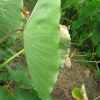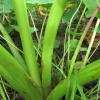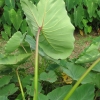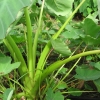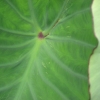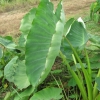Use As Food
Mainly as table taro; to a certain extent for taro sprouts.
Distribution
Most important Japanese variety in Hawaii, grown throughout the islands, almost exclusively under dryland culture (māla) by Japanese gardeners, usually under irrigation alongside other vegetable crops.
General Characteristics
Short, spreading, moderately stocky, often maturing within 6 months, producing as many as 40 ‘ohā, mostly dormant; distinguished by light green Hā (Petiole) and divergent Hā (Petiole) lihi māwae (sinus).
Ha (Petiole)
55 to 80 cm. long, light green with slight light brown flecking near kōhina (base), white to greenish-white at kōhina (base), reddishpurple at apex, with inconspicuous reddish edge; lihi mawae (sinus) widely divergent.
Lau or Lu'au(Leaf Blade)
35 to 50 cm. long, 25 to 40 cm. wide, 30 to 45 cm. from tip to base of sinus, narrowly egg-shaped (ovate), firm-chartaceous (paper like), light green with bluish cast; margins finely wave-like (undulate), the marginal veins often purplish; piko yellowish to light purple; round leaf section (lobes) obtuse to slightly acute with shallow, wide lihi māwae (sinus).
'I'o kalo (Corm)
Flesh white with yellowish fibers; skin white; ‘I‘o kalo (Corm) about 3 to 5 cm. in diameter.
Pua (Flower)
Remarks
Parent ‘I‘o kalo (Corm) are discarded because of their pronounced acridity (bitter). The ‘ohā are much smaller than those of the other Japanese varieties and are the only ones which cause itchy irritation from the calcium oxalate crystals. They are pared under water to prevent itching hands. If the ‘I’o kalo (Corm) develop top growth, they become acrid (bitter) and are discarded. The popularity of this variety is due primarily to the excellent keeping quality.


